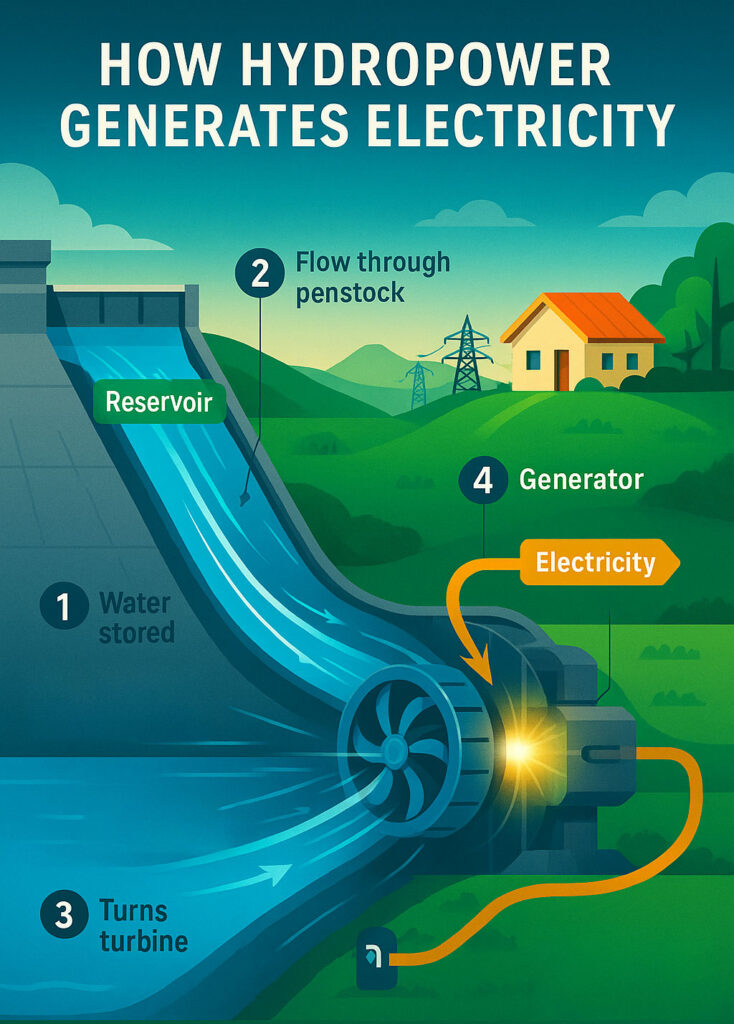Key Takeaways
- Hydropower turns moving water into renewable, reliable electricity.
- It provides about 6-7% of U.S. electricity and roughly 30% of renewable generation.
- States like Washington, Oregon, and New York are hydropower leaders.
- While environmentally impactful in some cases, new tech and small-scale systems are making hydro cleaner and more efficient.
- It remains an essential backbone for a renewable, balanced energy future.
Hydropower, or hydroelectric power, is one of the oldest and most reliable ways humans have learned to turn nature into energy. At its core, hydropower uses the movement of water to generate electricity. When rivers flow or water falls from a height, that movement carries kinetic energy. Hydropower systems capture that energy and convert it into electricity using turbines and generators.
In other words, every time water flows downhill, whether through a river, waterfall, or dam, it’s an opportunity to produce clean, renewable power.
How Hydropower Generates Electricity

The process is surprisingly elegant. Here’s how it works step-by-step:
- Water Flow: Water from a river or reservoir flows through large pipes called penstocks.
- Turbine Movement: The force of the moving water spins blades of a turbine.
- Electric Generation: The turbine connects to a generator, which converts the spinning motion into electricity using electromagnetic induction.
- Transmission: The electricity is sent through transformers and power lines to homes, businesses, and communities.
There are a few main types of hydropower facilities:
- Impoundment Dams: The classic design, think Hoover Dam, stores water in a reservoir and releases it as needed to meet demand.
- Run-of-River Systems: These rely on natural river flow with little or no reservoir storage, making them less disruptive to the environment.
- Pumped Storage: These act like giant batteries, pumping water uphill when electricity is cheap and releasing it downhill when demand is high.
Hydropower in the U.S. Energy Mix
Hydropower is a quiet powerhouse in America’s electricity supply. As of recent years:
- It provides about 6–7% of total U.S. electricity generation.
- It accounts for roughly 30% of all renewable electricity produced in the country.
- The U.S. has over 2,200 hydropower plants, from massive dams to small community projects.
While it’s not growing as rapidly as solar or wind, hydropower remains a crucial “base load” source, providing steady, around-the-clock energy when other renewables can’t.
Where Hydropower Shines the Most
Hydropower thrives where there’s plenty of flowing water and elevation changes. The biggest producers in the U.S. are:
- Washington State: home to the mighty Grand Coulee Dam, generating more hydroelectricity than any other U.S. facility.
- Oregon and California: powered by the Columbia and Klamath River systems.
- New York: led by the Niagara Power Project.
- Alaska: countless rivers and rugged terrain make it ideal for smaller hydropower systems.
These states have turned their natural geography into clean energy advantages, and in many rural regions, hydropower provides the backbone of local grids.
Advantages of Hydropower
Hydropower has plenty of perks that have made it a renewable energy favorite for over a century:
- Renewable and Reliable: As long as rivers flow, hydropower can produce energy 24/7.
- Low Emissions: It doesn’t burn fossil fuels, so it produces almost no greenhouse gases once built.
- Fast Response Time: Hydropower plants can ramp up or down quickly to balance demand or fill in gaps from solar and wind.
- Water Management Benefits: Dams often provide flood control, irrigation, and recreation in addition to power generation.
Disadvantages and Environmental Concerns
Of course, hydropower isn’t perfect. Some of its downsides include:
- Ecosystem Disruption: Large dams can block fish migration, alter river ecosystems, and flood habitats.
- High Upfront Costs: Building a dam or major hydropower facility requires massive investment and long permitting processes.
- Drought Risk: Hydropower depends on consistent water flow, so droughts or climate change can limit generation.
- Community Impacts: Reservoir creation can displace local communities or affect traditional land use.
Fortunately, modern hydropower projects and retrofits are increasingly focused on minimizing environmental harm, for example, adding fish ladders or re-operating dams for better flow balance.
The Future of Hydropower
While most of the prime dam sites in the U.S. are already developed, hydropower still has room to grow. The future lies in:
- Modernization: Upgrading older dams with more efficient turbines and digital monitoring.
- Small and Micro Hydro: New technologies make it possible to harness small rivers and canals without major disruption.
- Pumped Storage Expansion: As solar and wind grow, pumped storage hydro will play a crucial role in balancing the grid and storing excess power.
- Hybrid Systems: Combining hydropower with solar or wind at the same site can make renewable power more consistent.
Globally, hydropower will remain a key player, especially in regions like South America, Asia, and Africa where vast untapped river systems can supply both electricity and economic growth.
Fun Facts About Hydropower
- The world’s first hydroelectric power plant opened in 1882 in Appleton, Wisconsin.
- China’s Three Gorges Dam is the largest hydropower facility on Earth, capable of producing more than 22,000 megawatts.
- The U.S. Bureau of Reclamation manages more than 50 hydroelectric plants that together produce enough electricity for 3.5 million homes each year.
- Some cities, like Seattle and Portland, get the majority of their electricity from hydropower, making them some of the greenest metro areas in the country.
FAQs About Hydropower
How does a hydropower plant work?
How much of the U.S. electricity comes from hydropower?
Which states use the most hydropower?
Is hydropower expensive to build or maintain?
Does hydropower harm the environment?
How does hydropower compare to solar and wind energy?
Is hydropower renewable?
What happens when there’s a drought?
How old is hydropower?
About the Author
David has been an integral part of some of the biggest utility sites on the internet, including InMyArea.com, HighSpeedInternet.com, BroadbandNow.com, and U.S. News. He brings over 15 years of experience writing about, compiling and analyzing utility data.
